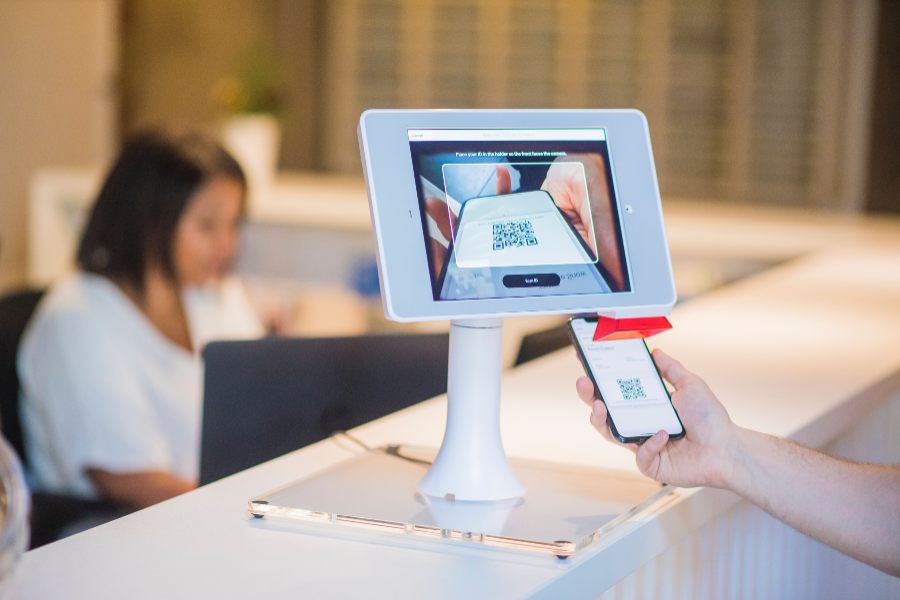
In an increasingly interconnected world, seamless integration has become a hallmark of efficient technology solutions. Interoperability, the ability of different systems to communicate and work together, has revolutionized various industries.
One such area where interoperability is proving its transformative prowess is in the realm of visitor management systems (VMS). These systems were once used for simple guest registration. Nowadays, they have evolved into multifaceted tools that enhance security, streamline operations, and elevate visitor experiences.
According to Maximize Market Research, the VMS sector was valued at US$ 931.2 million in 2021. Over the period 2021-2029, the market for visitor management systems is estimated to develop at a CAGR of 12.8%. The growing need for software-based security solutions is one of the key growth factors.
In this post, we will discuss the importance of interoperable VMS and how their integration capability is redefining access control.
The Evolution of VMS and Integration
From digital logbooks to advanced visitor engagement platforms, VMS has come a long way. Modern VMS solutions are no longer standalone entities; they thrive in collaboration. An interoperable visitor management system leverages APIs to integrate with existing systems, creating an ecosystem that is efficient and secure.
APIs, or application programming interfaces, are critical for software integration. According to a MuleSoft report, 84% of firms utilize APIs. The global API economy is expected to be valued at $267 billion by 2025. API-enabled businesses are 24% more likely to make a profit than those that do not.
Integration marks a shift from isolated data repositories to interconnected networks where information flows seamlessly between systems. This evolution has broad implications, transforming VMS into central hubs for managing various aspects of visitor interactions.
Access Control and VMS
As noted by TechTarget, there are two forms of access control: logical and physical. Physical access control is used to regulate access to buildings, cabins, campuses, and physical IT assets. Logical access control controls access to system data and computer networks.
Interoperability empowers VMS to synchronize with access control systems. This makes physical access control smarter and more agile. By exchanging data, these systems provide real-time access updates, allowing authorized personnel to swiftly manage visitor permissions and security protocols. This enhances both security and convenience.
For instance, when a visitor checks in through the VMS, the access control can grant them access to specified areas. Conversely, if a visitor’s authorization changes, the access control system can promptly reflect this update in the VMS. This dynamic exchange of information ensures that only approved visitors can access designated spaces.
Data Unification and Insights
Interoperable VMS bridges the data divide. According to Greetly, VMS shares valuable information by linking with databases, CRM, and employee directories. This offers insights into visitor patterns, preferences, and interactions.
In the past, data silos hindered organizations from fully understanding visitor behavior and engagement. Interoperability breaks down these barriers, allowing data to move readily between computers.
For instance, when VMS data is integrated with a CRM system, organizations can gain a view of each visitor’s history. This unified data enables personalized experiences, as hosts can access relevant information before meeting visitors.
Enhancing Visitor Experiences
Seamless integration augments visitor experiences. With interoperable VMS, the visitor journey becomes a well-orchestrated experience that starts before they even set foot on the premises. When guests arrive, hosts are immediately alerted, allowing them to greet them and lead them through the check-in process.
Pre-registered visitors receive automated notifications containing essential details, such as parking instructions, building access points, and appointment confirmations. These personalized messages enhance visitor preparedness and dispel any uncertainties regarding their visit.
Crisis Management and Evacuation
Interoperability transforms VMS into a vital tool during emergencies. VMS assists in emergency circumstances by giving real-time data through collaboration with emergency alerting systems. During a crisis, every second counts. Interoperable VMS contributes to safety and order by facilitating rapid response and informed decision-making.
In cases where evacuation is necessary, VMS can generate real-time reports on the number of visitors present and their locations. This information assists emergency teams in accounting for everyone and identifying potential hazards.
Workflows and Operational Efficiency
Operational efficiency blooms when VMS collaborates with workflow tools. Integration with communication platforms optimizes task assignments, ensuring visitors meet the right hosts promptly.
Interoperability bridges the gap between visitor management and overall operational workflows. By integrating VMS with communication and collaboration platforms, organizations create a seamless environment where visitor interactions align with business processes.
For instance, when a visitor checks in, the VMS can trigger notifications to hosts through communication platforms. This integration accelerates the coordination of meetings, ensuring that hosts are aware of upcoming visits and can prepare accordingly.
A Glimpse Into the Future
The potential of interoperable VMS is boundless. As artificial intelligence technologies advance, these systems can adapt to visitor behaviors, predicting their needs. Wearable integration might enable smooth check-ins and secure access through personalized devices.
The path of interoperable VMS is an ongoing evolution. As technology progresses, opportunities to enhance visitor management expand. Overall, rapid advancements in artificial intelligence will definitely shape the future of VMS.
Final Thoughts
The rise of interoperable VMS stands as a testament to the growing influence of integration in reshaping visitor experiences. The fusion of VMS with access control systems not only bolsters security but also enhances convenience through dynamic access updates.
Interconnected data networks allow for in-depth study of visitor behavior, which was previously hampered by data silos. Improved operational procedures, quick crisis response, and technological advancements indicate a future in which AI-powered VMS may predict visitor demands.
Finally, the VMS evolution showcases how integration reshapes norms, enhancing security, efficiency, and visitor focus with comprehensive, innovative solutions.


